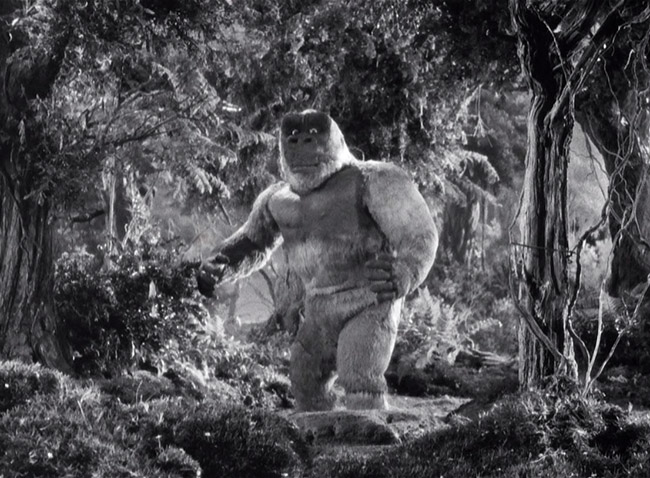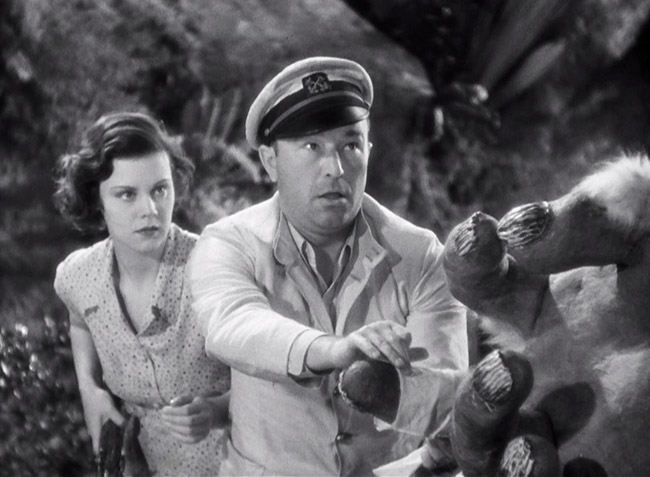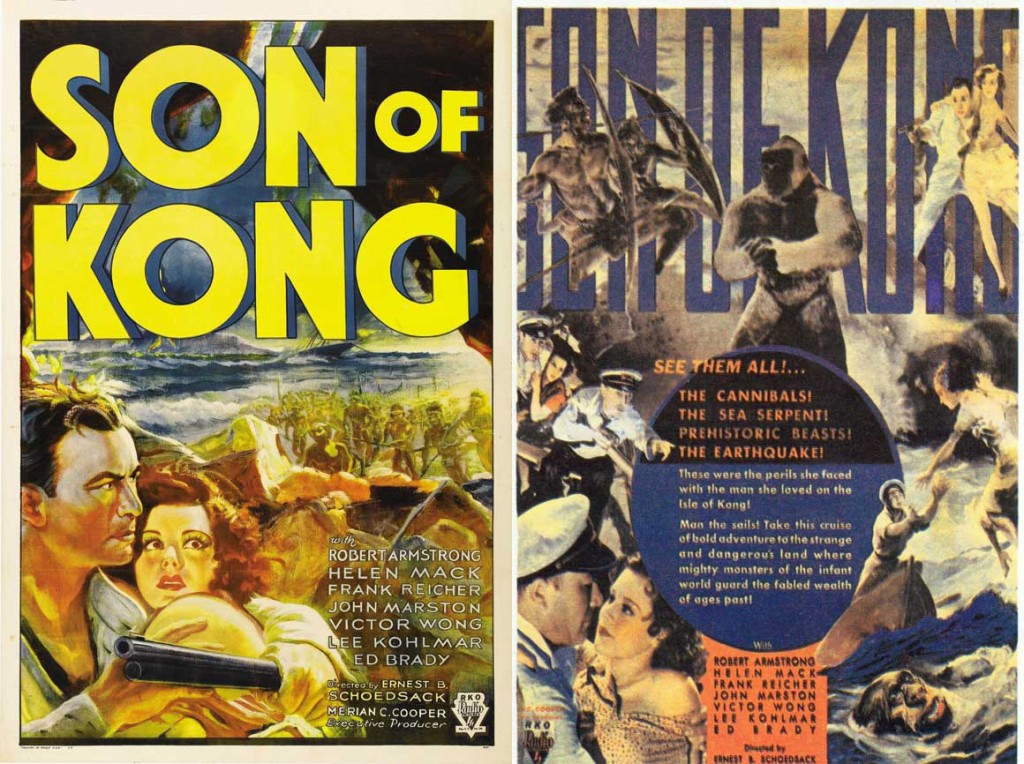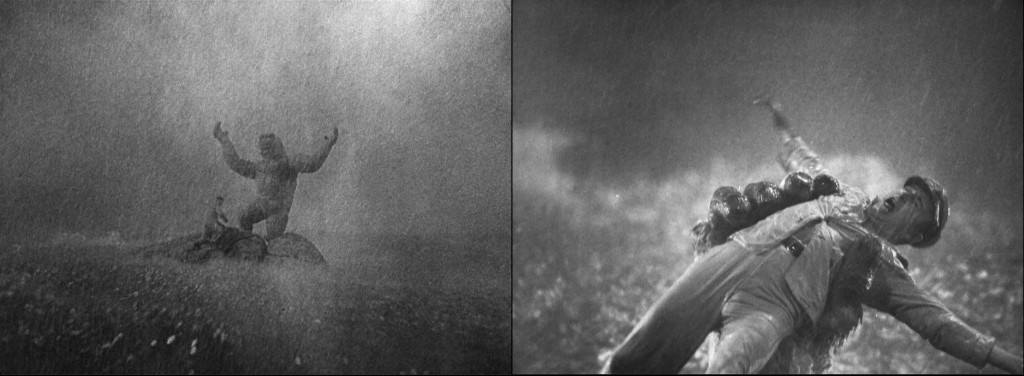
Maybe it’s telling that one of the most memorable moments in Son of Kong (1933) is a troupe of performing monkeys. Specifically, it’s a monkey orchestra, playing for some bored villagers in the Dutch East Indies. Hey, it’s an amazing performance – for a few minutes you get to watch in amazement as the film takes a smoke break, and monkeys play strings and percussion for your pleasure – but you can’t shake the feeling that our great Kong, Eighth Wonder of the World, is in danger of becoming just another performing monkey. RKO rushed Son of Kong into production, and the film reached theaters in the same calendar year as the original, landmark King Kong (1933). Ernest B. Schoedsack, who directed the original with Merian C. Cooper, returned to the director’s chair. Also returning was Robert Armstrong as the impresario Carl Denham. Willis O’Brien, whose special effects were a big part of what made King Kong and Skull Island so very special, ceded most of the stop motion work in the wake of personal tragedy. His ex-wife Hazel had contracted tuberculosis and was also diagnosed with cancer; increasingly unstable, she shot their two young sons while Son of Kong was still in production. She then attempted to take her own life, but survived her injuries (she finally succumbed the following year while interred at a prison ward in the L.A. General Hospital). With a devastated O’Brien sidelined, Son of Kong was nonetheless hurried to completion by RKO, largely under O’Brien’s assistant Buzz Gibson. Absent was the meticulous care with which the original Kong had been assembled. Kong’s offspring is largely played for comic relief – though at least he doesn’t have to play the violin.

Carl Denham (Robert Armstrong) and Hilda (Helen Mack) delicately inform the Son of Kong about the death of his father.
So this wasn’t an epic fantasy spectacle. Everything was trimmed, including the running time. This was a programmer. To the film’s credit, the opening is clever, in fact hilarious: Denham is holed up in his office, a poster for his King Kong exhibition on the wall, watching lawsuits pile up against him for all the damage and havoc wreaked by his Eighth Wonder of the World. It’s the aftermath we so rarely see in monster-on-the-rampage movies. After this witty prologue, Denham decides it’s best to leave the country quickly, and heads out to sea with the sympathetic Captain Englehorn (Frank Reicher, also reprising his role from King Kong). In the port of Dakang, they meet a lovely young Fay Wray type, Hilda (Helen Mack of Merian C. Cooper’s 1935 She), a brunette whose wobbly talent involves playing the guitar while singing in a Betty Boop voice. She’s travelling in a little circus with her father, but he’s killed after a fight with a drunken skipper named Nils Helstrom (John Marston). The forlorn Hilda wishes to join Denham’s ship, but he resists (despite the fact that he has no real reason to do so – it seems more than a bit heartless!). Finally she stows away, but is dismayed to see her father’s killer, Helstrom, has also joined the ship. Denham and Englehorn chart a course to Skull Island to find a hidden treasure horde, but the crew mutinies near the shore, and leave Denham, Englehorn, Hilda, Helstrom, and a Chinese cook named Charlie (Victor Wong, also of King Kong) adrift on an open boat. They reach Skull Island, but the natives remember Denham – the man who let Kong loose on their village. The castaways hastily row to the other side of the island. You know, the dinosaur side…
We’re over halfway through the film by the time some stop-motion creatures show up, and one can’t shake the feeling that the film is being padded with melodrama and, well, those performing monkeys. Then there’s another creature fest, but it’s lower rent than the original’s. The Son of Kong – “Little Kong” – is an albino ape much smaller than his daddy, curious about the interlopers and friendly. After Denham and Hilda rescue him from some quicksand, he reciprocates by saving them from a prehistoric bear. Meanwhile, the other castaways battle a triceratops, which charges them. Denham discovers a temple where the treasure lies, but an earthquake causes the island to begin sinking into the ocean. The evil Helstrom gets his comeuppance, chewed up in the jaws of a sea monster (a nothosaur). Denham finds himself stranded with Little Kong on the last peak of Skull Island as it sinks into the water, and, in an act of sacrifice, the ape holds Denham aloft, just long enough for the others to row in and rescue him – but the ape drowns. If the prologue of Son of Kong is the film commenting with wit upon the events of the first film, it’s here in the climax that the film treats them with poignancy. The ape holds Denham in his fist like a Fay Wray, like an act of forgiveness; it wasn’t much earlier that Denham attempted to explain, and to apologize for, the death of the ape’s father, while bandaging a thick, fur-covered finger. What’s more important than the ape’s feelings (which are debatable) is that Denham overcome his guilt over what happened back in Manhattan. (It should be pointed out that the idea that these two apes are related is conjecture on Denham’s part – a reflection of his ballyhoo-pointed personality. One might instead speculate that the two apes belong to different evolutionary branches, given the difference in scale and, possibly, the albino pigmentation of “Little Kong.”) If this all seems crudely handled, well, at least it’s more subtle than some of the promotional art depicting Little Kong drowning with Hilda, not Denham, in his hand – essentially promising viewers they will get pretty much the exact same thing as the original King Kong. That, of course, was not true in many respects. Son of Kong is a slight film, but it’s easy to imagine what a better, more carefully produced version of this story might have been. That’s because the better sequel was made, a decade and a half later – it’s called Mighty Joe Young (1949) – and O’Brien, on that do-over, would be assisted by Ray Harryhausen, who would carry the torch to a bevy of truly worthy stop-motion spectacles. Both Son of Kong and Mighty Joe Young are now available on Blu-Ray as part of Warner’s four-film Special Effects Collection, alongside Harryhausen’s classic The Beast from 20,000 Fathoms (1953) and the seminal giant-bug movie Them! (1954).











